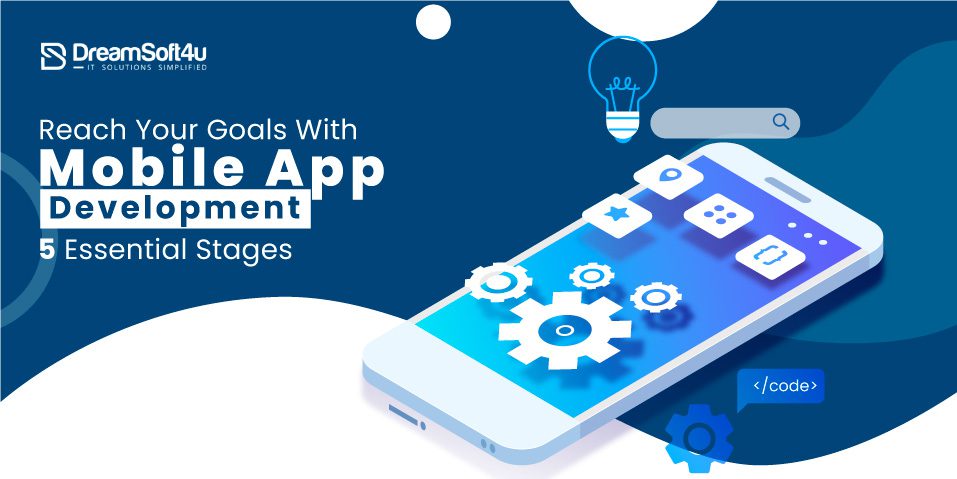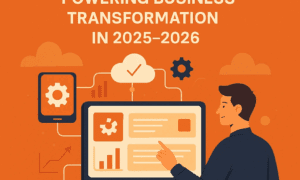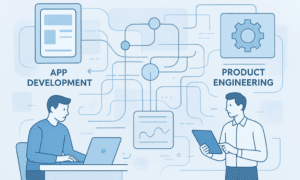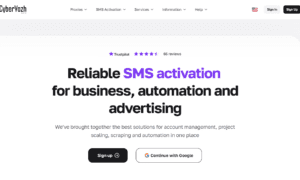Having a fantastic app idea is important. However it takes time and effort to develop that concept into a whole business application. There are five key steps in the process of mobile app development.
In this blog, we’ll break down each of the five stages. It will help you identify exactly what steps must be taken to reach your goals.
How to create an app?

Creating a mobile app can be a complex process. From defining the app’s target audience to designing the user interface and coding the functionality, several important steps exist. Let’s look at the 5 key stages of mobile app development process.
Stage 1: Planning Your App’s Objectives and Strategies?
Remember, knowing the whys helps you answer the ‘hows.’ By planning, you’ll be better positioned to succeed with your mobile app design!
Start by identifying the exact needs and goals of your app. For instance, if you are building a consumer-centric app, identify your target audience, their needs, and their key pain points.
Consider which platforms and devices the mobile app needs to support. Also, highlight features that will set your app apart from your rivals and draw people in. Besides these, get a rough estimate of the app’s budget, required technology stack, and development hours.
Stage 2: Design UX/UI Elements
Your mobile app design will determine whether it gets noticed or if people leave it quickly. The important thing, in this case, is to design your app with user experience and interface principles in mind. UX/UI ensures that your consumers have a pleasurable, straightforward experience that encourages them to use and explore your app more frequently.
Keep these points in mind:
- Ensure navigation is straightforward
- Optimize for mobile and take into account different screen resolutions;
- Fostering engagement through clear visuals, and thoughtful transitions
- Provide app users with clear pathways to other app areas
- Encourage users to explore additional features using meaningful content and animations.
Stage 3: Implement Technology, Features, and Functionality
Now that your mobile app design and strategy are complete let’s move to the implementation phase. During this phase, you’ll choose the technology, features, and functionality employed.
Begin with identifying the platforms that your app will be used on. Will you build for iOS or Android or both? You should also identify the technology stack to help you build the app. Equally important are third-party services that can accelerate development. This can include payment gateways, social media integration, and others.
Single or Native Codebase
To simplify app extensions and maintenance, you should aim for a manageable, scalable codebase. This can vary depending on the language or framework you select. Compared to native platforms, cross-platform frameworks save time and money. You simply have to write the code once and use it for all platforms.
Stage 4: Testing and Debugging
This is the stage that most companies and businesses tend to overlook during the mobile app development project. Although this stage can be time-consuming and tiresome, it doesn’t mean that it can be ignored or downplayed. The right testing and debugging strategy helps you identify issues that can quickly escalate into a huge business loss once the app is launched.
This stage also ensures that your app’s perfectly fine-tuned to deliver a faultless user experience. Here are a few of the critical areas that need to be tested:
- App loading time: Ensure the app loads quickly on a range of devices and across multiple screen sizes
- Usability: Ensure that app navigation is simple and straightforward. Users should be able to quickly figure out how to use the app and complete tasks effectively.
- Debugging: Fix any flaws or issues that may have been overlooked earlier, such as code or copywriting mistakes.
Testing still has another significant advantage. Before launch, you can utilize it to receive feedback from actual users. This input helps point out issues or features that must be improved before launch.
Your chances of success will considerably rise if you put in the time and effort necessary for testing and debugging during mobile app development, so don’t skip this stage!
Stage 5: Launching the Mobile App
Finally, testing and debugging are done, and your app is working like a breeze-its time to launch. But you should follow some rules and guidelines to ensure a successful app launch. Remember, the goal is to increase your app’s visibility and guarantee a positive user experience.
Here are a few things to keep in mind:
- Identify who your target market is- understand app user preferences.
- Consider feedback from pre-launch tests and use them to advertise to your target users.
- Have a marketing strategy in place. Leverage social media, influencer marketing, or digital advertising to help get the word out.
- Last but not least, be prepared for post-launch maintenance and optimization; staying current with the trends in mobile technology is critical.
By following these guidelines and taking some extra steps during this stage of Mobile App Development, you can ensure that your app is successful once it launches!
Analyze: Track Progress and Performance With Data Analytics
The key to long-term success is understanding better how people interact with your mobile app through data analysis. But what does this involve?
Setting up analytics tools
To track user involvement with your app, you must first set up analytics tools like Google Analytics or MixPanel. It will enable you to track or measure key performance metrics like how often users open your app, the average session length, and the most liked and used products/features.
Making sense of data
Understanding how to interpret this data is the second stage. You can learn much about user behavior by looking at analytics data and choosing how to optimize your product offering best.
And Finally…Act on the Data!
The last stage is acting on this data to make adjustments as necessary. This includes changing or adding new features, improving design components, doing A/B tests, and much more!
Final Words
Successful mobile app development requires a lot of planning, effort and commitment. Of course, you need a great team as well. If you dontl have the resources neede, it’s always wise to hire an expert. Partnering with the right mobile app development services , will ensure your app reaches its utmost potential.
If you need help, it is always wise to consult top-rated technology partners like DreamSoft4u. Whether you need consultation for the android app development process step-by-step or need help with your app launch and maintenance, DreamSoft4u is a name you can always trust.

































